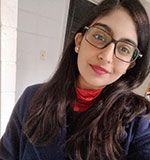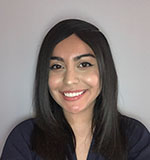From Lab to Poster
Students learn the importance of visual communication as they present their research findings to industry leaders at the MBP Research Symposium.
The adage of “Show, don’t tell” has crossed over from the world of creative writers to those in Northwestern Engineering's Master of Biotechnology Program (MBP).
The technique encourages storytellers to draw in the audience with sensory details. It also can be used not just in fables and novels but also in presentations of scientific research, MBP students learned.
Each year, MBP students showcase findings from their research during the year at the program's Research Symposium to members of the MBP Industrial Advisory Board (IAB). The IAB is composed of industry leaders and helps ensure that what students learn in MBP remains aligned with what employers need.
The symposium is divided into two parts – an oral presentation and a poster presentation. Deepali Venkatesh Prasanna and Yvette Calvillo were two of the top three finishers in the poster portion of the competition.
Both said the key to their success was giving the judges – IAB board members, MBP faculty, and fellow students – a narrative to follow and attractive visuals to draw them into the story behind their research.
 “I had to convince another person who had never heard about this topic or project about its importance and applications,” Venkatesh Prasanna said. “It boosted my confidence with respect to scientific presentation and taught me to be quick on my feet.”
“I had to convince another person who had never heard about this topic or project about its importance and applications,” Venkatesh Prasanna said. “It boosted my confidence with respect to scientific presentation and taught me to be quick on my feet.”
One of the main focuses in MBP is to create not just scientifically accomplished graduates but graduates who are able to clearly and effectively communicate their work to a variety of different audiences.
Venkatesh Prasanna's poster used an animated cartoon diagram and easy-to-understand, attractive figures to attract people’s attention. Calvillo used colorful, high-resolution images and organized a wealth of data into clear graphics.
Venkatesh Prasanna's research focused on what’s called lasso peptides — natural products found in bacteria. Her hope is that her research one day will lead to new treatments for bacterial infections. Calvillo’s work examined how tooth enamel forms from a set of proteins and where mutations can occur.
Both students did their research at Northwestern. Venkatesh Prasanna's work comes from the Jewett Lab under Michael C. Jewett. Calvillo's work was done in the Joester Lab of Derk Joester, in collaboration with the University of California San Francisco’s School of Dentistry.
Part of the symposium’s allure for the students was the opportunity to take their work out of the lab to gauge its potential.
“It was nice to see how feasible they thought our research projects were to the real world,” Venkatesh Prasanna said. “After all, one of the goals of research is commercialization.”
The feedback itself is something students can use to sharpen their presentation skills for future opportunities.
 “This experience taught me to better articulate my research findings,” Calvillo said. “Receiving feedback from these skilled professionals allowed us to improve our ability to effectively share our research findings with individuals both within our field as well as in other fields.“
“This experience taught me to better articulate my research findings,” Calvillo said. “Receiving feedback from these skilled professionals allowed us to improve our ability to effectively share our research findings with individuals both within our field as well as in other fields.“
Both said they found tremendous value in participating in the symposium and are appreciative of MBP leaders for organizing it.
“It gave us a wonderful opportunity to present our work,” Venkatesh Prasanna said. “I know that this will prove useful when I am presenting to fellowship committees, grant committees, or even at corporate meetings.”

